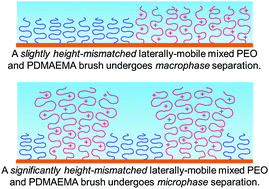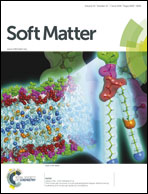Macroscopic lateral heterogeneity observed in a laterally mobile immiscible mixed polyelectrolyte–neutral polymer brush†
Abstract
We studied mixed poly(ethylene oxide) (PEO) and poly(2-(dimethylamino)ethyl methacrylate) (PDMAEMA) brushes. The question we attempted to answer was: when the chain grafting points are laterally mobile, how will this lateral mobility influence the structure and phase behavior of the mixed brush? Three different model mixed PEO/PDMAEMA brush systems were prepared: (1) a laterally mobile mixed brush by spreading onto the air–water interface a mixture of poly(ethylene oxide)–poly(n-butyl acrylate) (PEO–PnBA) and poly(2-(dimethylamino)ethyl methacrylate)–poly(n-butyl acrylate) (PDMAEMA–PnBA) diblock copolymers (the specific diblock copolymers used will be denoted as PEO113–PnBA100 and PDMAEMA118–PnBA100, where the subscripts refer to the number-average degrees of polymerization of the individual blocks), (2) a mobility-restricted (inseparable) version of the above mixed brush prepared using a PEO–PnBA–PDMAEMA triblock copolymer (denoted as PEO113–PnBA89–PDMAEMA120) having respective brush molecular weights matched with those of the diblock copolymers, and (3) a different laterally mobile mixed PEO and PDMAEMA brush prepared from a PEO113–PnBA100 and PDMAEMA200–PnBA103 diblock copolymer combination, which represents a further more height-mismatched mixed brush situation than described in (1). These three mixed brush systems were investigated by surface pressure–area isotherm and X-ray (XR) reflectivity measurements. These experimental data were analyzed within the theoretical framework of a continuum self-consistent field (SCF) polymer brush model. The combined experimental and theoretical results suggest that the mobile mixed brush derived using the PEO113–PnBA100 and PDMAEMA118–PnBA100 combination (i.e., mixed brush System #1) undergoes a lateral macroscopic phase separation at high chain grafting densities, whereas the more height-mismatched system (System #3) is only microscopically phase separated under comparable brush density conditions even though the lateral mobility of the grafted chains is unrestricted. The macroscopic phase separation observed in the laterally mobile mixed brush system is in contrast with the microphase separation behavior commonly observed in two-dimensional laterally mobile charged small molecule mixtures. Further study is needed to determine the detailed morphologies of the macro- and microphase-separated mixed PEO/PDMAEMA brushes.


 Please wait while we load your content...
Please wait while we load your content...